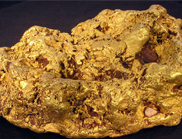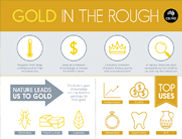CSIRO uses x-ray vision to detect unseen gold
Working with Canadian company Mevex, CSIRO has conducted a pilot study that shows that gamma-activation analysis (GAA) offers a much faster, more accurate way to detect gold than traditional chemical analysis methods.
This will mean mining companies can measure what’s coming in and out of their processing plants with greater accuracy, allowing them to monitor process performance and recover small traces of gold – worth millions of dollars – that would otherwise be discarded.
GAA works by scanning mineral samples – typically weighing around half a kilogram – using high-energy x-rays similar to those used to treat patients in hospitals. The x-rays activate any gold in the sample, and the activation is then picked up using a sensitive detector.
According to project leader Dr James Tickner, CSIRO’s study showed that this method is two-to-three times more accurate than the standard industry technique ‘fire assay’, which requires samples to be heated up to 1200°C.
“The big challenge for this project was to push the sensitivity of GAA to detect gold at much lower levels – well below a threshold of one gram per tonne,” he says.
Last year, Australia produced over A$10 billion worth of gold. Even if GAA only led to a modest 5 per cent improvement in recovery, that would be worth half a billion dollars annually to the industry.
Dr Tickner explains that a gold processing plant may only recover between 65 and 85 per cent of gold present in mined rock. Given a typical plant produces around A$1 billion of gold each year, this means hundreds of millions of dollars worth of gold is going to waste.
“Our experience suggests that better process monitoring can help reduce this loss by about a third,” he says.
Last year, Australia produced over A$10 billion worth of gold. Even if GAA only led to a modest 5 per cent improvement in recovery, that would be worth half a billion dollars annually to the industry.
Dr Tickner says that the other major benefit of GAA is that it is easily automated, allowing for much quicker analysis of ore samples.
“Fire assay usually involves sending samples off to a central lab and waiting several days for the results. Using GAA we can do the analysis in a matter of minutes, allowing companies to respond much more quickly to the data they’re collecting.”
“A compact GAA facility could even be trucked out to remote sites for rapid, on-the-spot analysis.”
Another great advantage of GAA is that it is more sustainable – unlike fire assay it doesn’t require the use of heavy metals such as lead.
It is also very adaptable. “While most of the work we’ve done has been based on the gold industry, the technique can be modified for other valuable commodities such as silver, lead, zinc, tin, copper and the platinum group metals.”
Now that the research team has proved the effectiveness of the technique, their next goal is to partner with local and international companies in order to get a full-scale analysis facility up and running in Australia. They hope to achieve this within the next two years.
Media resources
Click image for high resolution version



